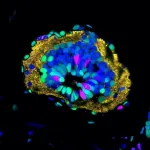Personality traits relate to being a morning or evening person
2021-06-22
(Press-News.org) The relationship between personality, genes and chronotype (sleep patterns) has been studied by researchers at the University of Warwick and the University of Tartu, Estonia
People high in Conscientiousness and low in Openness are rather morning people; lower-level personality traits such as self-discipline, excitement-seeking, and straightforwardness have also been linked to chronotype
It is partly due to genetic factors, but there is scope to change your sleep patterns if you wanted to become a morning person but are currently an evening person for example
The link between the different hierarchies of personality, sleep patterns and even genetics has been discovered by researchers from the Department of Psychology at the University of Warwick.
A typical example of a morning person is thought to be someone who wakes up naturally at 6am, goes for a jog, showers, has breakfast and is ready for a productive day at work by 9am. Whereas an evening person struggles to get up in the morning and feels more productive in the evening.
Researchers from the University of Warwick with colleagues from the University of Tartu have recently had the paper, 'Personality Traits Relate to Chronotype at Both the Phenotypic and Genetic Level' published in the Journal of Personality, in which they have analysed the relationship between sleep timing (chronotype), preference to the morning/evening, and personality traits at a phenotypic and genetic level.
Ultimately the researchers have found that the relationship between personality and morningness-eveningness is partly due to genetic factors.
Using a large-scale sample of participants form the Estonian Biobank researchers asked them to answer questionnaires about their sleep timings and personality, personality was also assessed by someone who knew the participant well. Once answered researchers were able to identify the phenotypic relationships between the sleep and personality.
However they were also able to calculate the genetic correlations through summary statistics of large genome-wide association studies of personality and sleep preferences.
Personalities can be divided into three hierarchies: personality domains, facets and items, researchers analysed all three, but in particular they found on a domain level that people high in Conscientiousness and low in Openness were associated with being earlier chronotypes (i.e., they went to bed and got out of bed earlier).
On a facet level, researchers found that less straightforward (a facet of Agreeableness) and excitement-seeking (a facet of Extraversion), yet more self-disciplined (a facet of Conscientiousness) people were more likely to have earlier chronotypes. Higher Conscientiousness and lower Openness were also genetically related to preference for morningness.
Postgraduate researcher Dr Anita Lenneis, from the Department of Psychology at the University of Warwick comments:
"Our findings have helped us to come up with two possible pathways of how personality might influence chronotype. Personality traits such as Conscientiousness and C5: Self-discipline in particular may influence chronotype through shaping people's preferences for various social activities and behaviours which in turn, may influence what time people go to and get out of bed, or personality may influence chronotype is through active decisions people make regarding their sleep.
"However, it could also be that chronotype influences personality or that chronotype and personality mutually influence each other. The findings of the genetic correlations support this view but further studies will be necessary to better understand the shared genetic mechanisms between the two constructs as well as the causality of their relationships."
Professor Anu Realo, from the Department of Psychology at the University of Warwick adds:
"Not only have we shown there is a relationship between chronotype, personality and partially your genes, our findings also suggest that it might be possible to change your chronotype or at least train yourself into a different more socially convenient sleep pattern by increasing your self-control. Ideally work hours would be adapted to your chronotype, but if not, evening people who typically experience worse health could learn to go to bed at earlier hours which might also accelerate the release of melatonin. Melatonin is also influenced by artificial light, so regularly turning off the lights at earlier hours might also lead to falling asleep at earlier hours of the evening. However, future studies will need to investigate whether such interventions to enhance self-control would result in a permanent change or would indeed promote better health in later chronotypes."
INFORMATION:
ELSE PRESS RELEASES FROM THIS DATE:
2021-06-22
Coastal wetlands like seagrass meadows, mangroves, and salt marshes play vital roles along the shoreline, from providing a buffer against storm surges, to providing critical habitat for animals, to capturing atmospheric carbon.
We are still just beginning to comprehend the intricate workings of these highly productive ecosystems and their role in mitigating the climate crisis, but UConn researchers are one step closer to understanding how salt marsh vegetation, their bacterial communities, and vegetation can help predict a marsh's potential to be a blue carbon reservoir. The research was recently published in the journal Estuaries and Coasts.
"Coastal marshes are increasingly recognized as important ecosystems because they sequester and store a lot of carbon. There is ...
2021-06-22
Most of us have genetic variations that increase the risk of medicinal products not being effective. In order to provide a more effective treatment with fewer side effects, we need to analyse more of these genetic variations. This will provide us with more precise knowledge about how the individual patient reacts to medicinal products. A new research result from Aarhus University shows that.
Personalised medicine has been a hot topic in recent years, using information about the genes to adapt the treatment to the individual patient. Personalised medicine potentially provides better treatment and fewer side effects for the patient. At least in ...
2021-06-22
WASHINGTON, June 22, 2021 -- About 2.2 billion people globally lack reliable access to clean drinking water, according to the United Nations, and the growing impacts of climate change are likely to worsen this reality.
Solar steam generation (SSG) has emerged as a promising renewable energy technology for water harvesting, desalination, and purification that could benefit people who need it most in remote communities, disaster-relief areas, and developing nations. In Applied Physics Letters, by AIP Publishing, Virginia Tech researchers developed a synthetic tree to enhance SSG.
SSG turns solar energy into heat. Water from a storage ...
2021-06-22
A team of scientists from the Leibniz Institute for Food Systems Biology at the Technical University of Munich has now discovered that the odorant receptor OR5K1 is specialized to recognize pyrazines in both humans and domesticated animals. These are volatile substances that contribute to the typical odor of many vegetables or are formed when food is heated. In addition, pyrazines also play a role as signaling substances in intra- or interspecific communication. The new research results contribute to a better understanding of the molecular mechanisms underlying the odor perception ...
2021-06-22
A single measurement result is not a proof - this has been shown again and again in science. We can only really rely on a research result when it has been measured several times, preferably by different research teams, in slightly different ways. In this way, errors can usually be detected sooner or later.
However, a new study by Prof. Andrej Pustogow from the Institute of Solid State Physics at TU Wien together with other international research teams shows that this can sometimes take quite a long time. The investigation of strontium ruthenate, a material that plays an important role in unconventional superconductivity, has now disproved an experiment that gained fame in the 1990s: it was believed that a novel form of superconductivity ...
2021-06-22
The spinal cord is an important component of our central nervous system: it connects the brain with the rest of the body and plays a crucial part in coordinating our sensations with our actions. Falls, violence, disease - various forms of trauma can cause irreversible damage to the spinal cord, leading to paralysis, sometimes even death.
Although many vertebrates, including humans, are unable to recover from a spinal cord injury, some animals stand out. For instance, the axolotl (Ambystoma mexicanum), a salamander from Mexico, has the remarkable ability to regenerate its spinal cord after an injury. When an axolotl's tail is amputated, neural stem cells residing in the spinal cord are recruited to the injury ...
2021-06-22
Researchers have identified a combination of biological markers in patients with dengue that could predict whether they go on to develop moderate to severe disease, according to a study published today in eLife.
Biomarkers are used to identify the state or risk of a disease in patients. Examples of biomarkers can include naturally occurring molecules or genes in the vascular, inflammatory or other biological pathways. The new findings could aid the development of biomarker panels for clinical use and help improve triage and risk prediction in patients with dengue.
Dengue is the most common mosquito-borne viral disease to affect humans globally. In 2019, the World Health Organization identified dengue as one of the top 10 threats to global health, with transmission occurring ...
2021-06-22
The ancient Maya city of Tikal was a bustling metropolis and home to tens of thousands of people.
The city comprised roads, paved plazas, towering pyramids, temples and palaces and thousands of homes for its residents, all supported by agriculture.
Now researchers at the University of Cincinnati say Tikal's reservoirs -- critical sources of city drinking water -- were lined with trees and wild vegetation that would have provided scenic natural beauty in the heart of the busy city.
UC researchers developed a novel system to analyze ancient plant DNA in the sediment of Tikal's temple and palace reservoirs to identify more than 30 species ...
2021-06-22
HOUSTON - (June 22, 2021) - How do you kill tumor cells that can't be targeted? Get their more susceptible neighbors to help.
The Rice University lab of synthetic chemist K.C. Nicolaou, in collaboration with AbbVie Inc., has created unique antibody-drug conjugates (ADCs) that link a synthetic uncialamycin analogue to antibodies that target cancer cells.
Once they enter the targeted tumor cells, these ADCs exhibit a "significant bystander effect," according to the study. In other words, cancerous neighbor cells that aren't directly attacked by the drugs are also affected.
The study in the Proceedings of the National Academy of Sciences presents "an intriguing opportunity ...
2021-06-22
Researchers at the University of Cincinnati College of Medicine have developed a blueprint for a protein that plays an important role in the development and regulation of reproductive organs.
The knowledge advances our understanding of the protein anti-Müllerian hormone hormone (AMH), which helps form male reproductive organs and in females regulates follicle development and ovulation in the ovaries, explains Thomas Thompson, PhD, professor in the UC Department of Molecular Genetics, Biochemistry and Microbiology.
Scientists have been looking to regulate AMH because it might play a role in developing a novel contraceptive, aid in treatments for infertility ...
LAST 30 PRESS RELEASES:
[Press-News.org] Personality traits relate to being a morning or evening person







